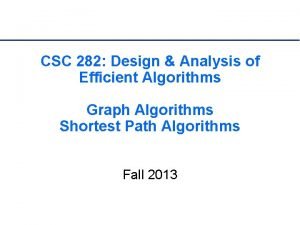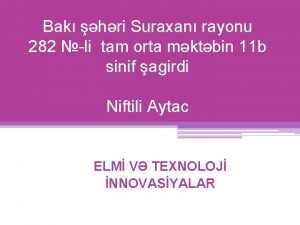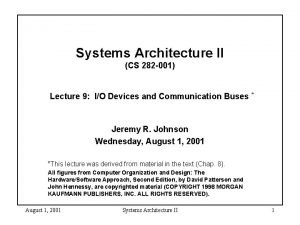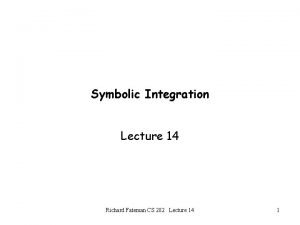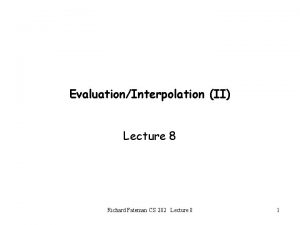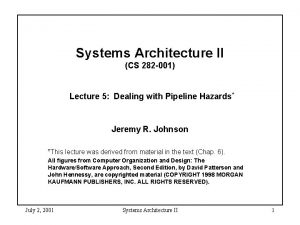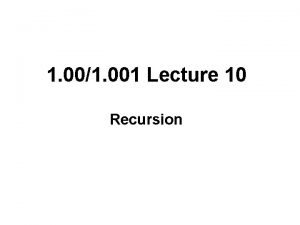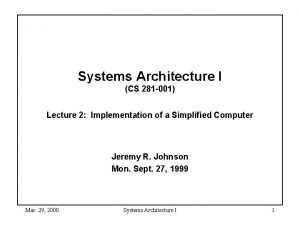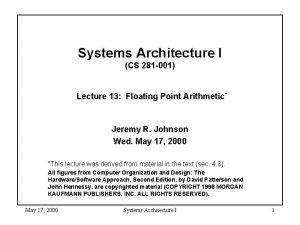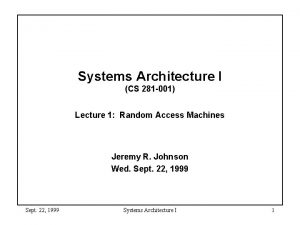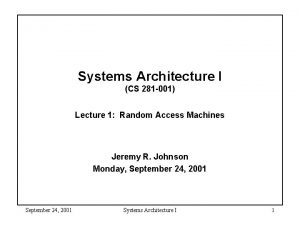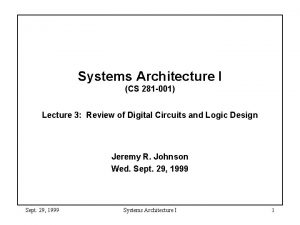Systems Architecture II CS 282 001 Lecture 11














- Slides: 14

Systems Architecture II (CS 282 -001) Lecture 11: Multiprocessors: Uniform Memory Access * Jeremy R. Johnson Monday, August 13, 2001 *This lecture was derived from material in the text (Chap. 9). All figures from Computer Organization and Design: The Hardware/Software Approach, Second Edition, by David Patterson and John Hennessy, are copyrighted material (COPYRIGHT 1998 MORGAN KAUFMANN PUBLISHERS, INC. ALL RIGHTS RESERVED). August 13, 2001 Systems Architecture II 1

Introduction • Objective: To use multiple processors to improve performance. To understand the performance gain that is possible and the basic design decisions. – – What are the limits to the speedup that can be obtained? How do parallel processors share data? How do parallel processors coordinate? How many processors? • Topics – Speedup and Amdahl’s Law – Different types of multiprocessors • Communication model • Physical connection – Multiprocessors connected by a single bus August 13, 2001 Systems Architecture II 2

Speedup and Amdahl’s Law • Speedup = Sequential execution time/Parallel execution time • Speedup. N = Sequential execution time / Execution time on N Processors • Amdahl’s Law: Execution Time After Improvement = Execution Time Unaffected + ( Execution Time Affected / Amount of Improvement ) August 13, 2001 Systems Architecture II 3

Speedup • Assume that the sequential execution time of a program is 100 sec and that 99% of the program can benefit from parallelism • The parallel execution time on N processors is: – 99/N + 1 sec • Speedup = 100/(99/N + 1) – Upper bound on speedup due to parallelism is 100 – Ideally we would hope for linear speedup. In this example after a certain point additional processors will produce diminishing returns. – How many processors are required to obtain a speedup of 90? August 13, 2001 Systems Architecture II 4

Speedup vs. Number of Processors August 13, 2001 Systems Architecture II 5

Limiting Speedup August 13, 2001 Systems Architecture II 6

Multiprocessor Design Choices • Single Address Space (Shared Memory) – Processors communicate through shared variables – Synchronization is used to protect processors from changing shared data simultaneously. Performed using a lock • Only one processor can obtain the lock at a time. Other processors must wait until the lock is released before accessing shared data. • After obtaining the lock the processor can safely modify shared data. – Uniform Memory Access (UMA). Also called Symmetric Multiprocessor (SMP) • Implementing UMA limits the number of processors • UMA commonly implemented using a shared bus – Non-uniform Memory Access (NUMA) • some memory accesses are faster than others depending on which processor asks for which word • Scales to larger number of processors • More difficult to effectively program August 13, 2001 Systems Architecture II 7

Multiprocessor Design Choices • Distributed Memory (separate private memories) – Processors communicate through message passing • send and receive primitives – Synchronization performed using send and receive – Processors connected via a network • In the extreme a cluster of workstations can communicate over a local area network August 13, 2001 Systems Architecture II 8

Shared Memory Programming • Example: Sum 100, 000 numbers (Assume 10 processors) • Each processor executes the same program (Pn = processor number), Array A contains shared data. sum[Pn] = 0; for (i=10000*Pn; i < 10000*(Pn + 1); i++) sum[Pn] = sum[Pn] + A[i]; half = 10; repeat synch(); /* wait for partial sum completion */ if (half % 2 != 0 && Pn == 0) sum[0] = sum[0] + sum[half -1]; half = half/2; if (Pn < half) sum[Pn] = sum[Pn] + sum[Pn + half]; until (half == 1); /* exit with final sum in sum[0] */ August 13, 2001 Systems Architecture II 9

Multiprocessors Connected by a Single Bus August 13, 2001 Systems Architecture II 10

Cache Coherency • Need to make sure that processor caches are consistent with each other and memory – exclusive access for a write – processors must have most recent copy when reading • Snooping: All cache controllers monitor, or snoop, on the bus to determine whether or not they have a copy of a shared block – When a write occurs either invalidate or update local copy. August 13, 2001 Systems Architecture II 11

Single-bus Multiprocessor using Snooping Cache Coherency August 13, 2001 Systems Architecture II 12

Implementation of Invalidate Protocol • Assume Write-Back Cache • Each cache block in 1 of 3 States: – Read Only – Read/Write – Invalid August 13, 2001 Systems Architecture II 13

Synchronization using Coherency • Atomic swap operation • Spin on local copy of lock • unlocked = 0 • locked = 1 August 13, 2001 Systems Architecture II 14
 282 ways to pass the earth science regents
282 ways to pass the earth science regents Code of hammurabi
Code of hammurabi Csc 282 rochester
Csc 282 rochester 27 miles per gallon into kilometers per liter
27 miles per gallon into kilometers per liter Path finding
Path finding 282 saylı orta məktəb
282 saylı orta məktəb Cs 282
Cs 282 Cs 282
Cs 282 Hima lakkaraju
Hima lakkaraju Concrodia library
Concrodia library Cs 282
Cs 282 Cross-lingual name tagging and linking for 282 languages
Cross-lingual name tagging and linking for 282 languages 01:640:244 lecture notes - lecture 15: plat, idah, farad
01:640:244 lecture notes - lecture 15: plat, idah, farad Computer architecture notes
Computer architecture notes Isa definition computer
Isa definition computer




